Information on Helicomatic systems is patchy at best. Any data below written in italic is from a single good resource but has not been verified. All other data has been verified by multiple sources or by checking objects the museum owns..
The main aim of the specifications below is to be aware of what to look for when trying to buy spare parts.
The racing models where produced in the following quality ranges (in brackets the main difference from the other models is listed).:
Sport ( 9 1/4" ball bearings on either side of the hub)
500 and 600 (13 5/32" ball bearings on either side of the hub)
700 Professional (This model had a finer threaded axle and different cones than the 500 and 600 models. Hubs were also better sealed. 13 5/32" ball bearings on either side of the hub)
All models can be fitted with Helicomatic freewheels that have a hole of 27mm.
All hubs where for 36 spokes and were build for fork dropout widths of 122 or 126mm
Freewheel assemblies (SH 27) came in 5 to 8 speed models. The spacers for the 5 speed are wider (approx 3 mm) than for other assemblies ( approx 2 mm). (The 8 speed was not actually used for racers but for commuter cycles, however this does not mean that you could not stick it on your racer).
All freewheel models (SH) can only be used on the splined helical hub except for the Helicomatic 2000 freewheels (SHC) these could be used on both the helical hub and a maillard threaded hub.
In the Maillard 1982 freewheel brochure cogs for the 600 SH racing freewheels came in 13 to 32 teeth (six speed) and 14 to 32 for the five speed. In the same catalog you could purchase for the 700 SH racing freewheel individual cogs. The specifications for these can be found in the diagrams to the right. The only additional point worth noting is that the SHE cogs threads onto the SHD. SHB, SHD and SHF all thread onto the freewheel. SHA are not threaded but slide into vertical splines on the hub.
Allthough the brochure does not mention it, the 600 SH model freewheel has the same dimensions as the 700 so customizing gearing is possible.
For the 8 speed model (used in commuter/touring cycles) the top cog is actually part of the freewheel body and all the other cogs slide onto the freewheel from the bottom (SHA).
For the 5 speed hubs you could use a standard chain, anything upwards requires a 'narrow' chain.
Lockrings come in three types, for 5 and 6 speed freewheels (the difference in spacer width means these freewheels are equal in height) and different lockrings for 7 and 8 speed. These are higher.
These hubs are not labeled Helicomatic but Diabolo.
Hubs for ATB/MTB were constructed for a fork width of 126mm. These use 9 1/4" ball bearings. The hubs are sealed.
The hole of the freewheel is 34 mm. Wider than the racing model and therefore incompatible. Cogs are also not interchangeable with racing freewheels. The helical splines on the hub are also shorter than on the racing model.
Freewheel assemblies come in 5 to 6 speeds (SH 34).
BMX bikes can be found with Helicomatic branded hubs and Diabolo branded hubs. This gives riders the choice between the 'slim´ look of a racing hub and the beefier 'fat' look of the Diabolo.
The single speed freewheel for BMX requires a shorter ontake on the hub for both types of hub. The museum owns only freewheels that fit a 27 mm splined hub, but assumes there must be 34 mm freewheels as well (Diabolo size).
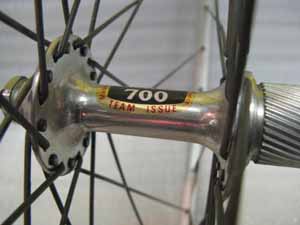
Maillard 700 Professional 'Team Issue' Helicomatic hub.
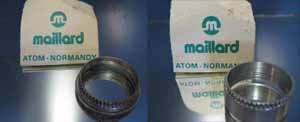
Lockrings, on the left the 5-6 speed lockring,
a 7 speed lockring on the right.
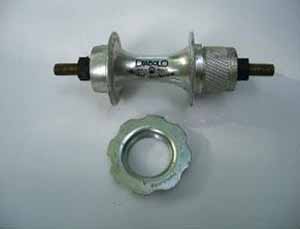
Maillard Diabolo hub and lockring.
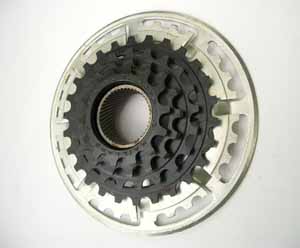
Maillard SH 34 freewheel assembly.
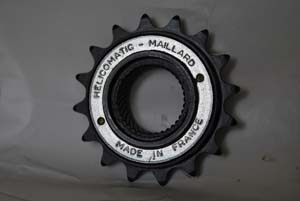
Single speed BMX freewheel